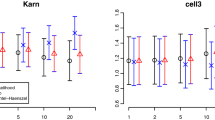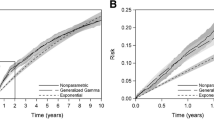Abstract
Parametric models used in time to event analyses are evaluated typically by survival-based visual predictive checks (VPC). Kaplan–Meier survival curves for the observed data are compared with those estimated using model-simulated data. Because the derivative of the log of the survival curve is related to the hazard—the typical quantity modeled in parametric analysis—isolation, interpretation and correction of deficiencies in the hazard model determined by inspection of survival-based VPC’s is indirect and thus more difficult. The purpose of this study is to assess the performance of nonparametric hazard estimators of hazard functions to evaluate their viability as VPC diagnostics. Histogram-based and kernel-smoothing estimators were evaluated in terms of bias of estimating the hazard for Weibull and bathtub-shape hazard scenarios. After the evaluation of bias, these nonparametric estimators were assessed as a method for VPC evaluation of the hazard model. The results showed that nonparametric hazard estimators performed reasonably at the sample sizes studied with greater bias near the boundaries (time equal to 0 and last observation) as expected. Flexible bandwidth and boundary correction methods reduced these biases. All the nonparametric estimators indicated a misfit of the Weibull model when the true hazard was a bathtub shape. Overall, hazard-based VPC plots enabled more direct interpretation of the VPC results compared to survival-based VPC plots.






Similar content being viewed by others
References
Cox EH, Veyrat-Follet C, Beal SL, Fuseau E, Kenkare S, Sheiner LB (1999) A population pharmacokinetic-pharmacodynamic analysis of repeated measures time-to-event pharmacodynamic responses: the antiemetic effect of ondansetron. J Pharmacokinet Biopharm 27(6):625–644
Bajaj G, Dombrowsky E, Yu Q, Agarwal B, Barrett JS (2013) Considerations for the prediction of survival time in pancreatic cancer based on registry data. J Pharmacokinet Pharmacodyn 40(4):527–536. doi:10.1007/s10928-013-9327-z
Suleiman AA, Frechen S, Scheffler M, Zander T, Kahraman D, Kobe C, Wolf J, Nogova L, Fuhr U (2015) Modeling tumor dynamics and overall survival in advanced non-small-cell lung cancer treated with erlotinib. J Thorac Oncol 10(1):84–92. doi:10.1097/jto.0000000000000330
Therneau TM, Grambsch PM, Fleming TR (1990) Martingale-based residuals for survival models. Biometrika 77(1):147–160. doi:10.2307/2336057
Cox DR, Snell EJ (1968) A general definition of residuals. J R Stat Soc 30(2):248–275. doi:10.2307/2984505
Schoenfeld D (1982) Partial residuals for the proportional hazards regression model. Biometrika 69(1):239–241. doi:10.2307/2335876
Farrington CP (2000) Residuals for proportional hazards models with interval-censored survival data. Biometrics 56(2):473–482
Vu TC, Nutt JG, Holford NH (2012) Disease progress and response to treatment as predictors of survival, disability, cognitive impairment and depression in Parkinson’s disease. Br J Clin Pharmacol 74(2):284–295. doi:10.1111/j.1365-2125.2012.04208.x
Friberg LE, de Greef R, Kerbusch T, Karlsson MO (2009) Modeling and simulation of the time course of asenapine exposure response and dropout patterns in acute schizophrenia. Clin Pharmacol Ther 86(1):84–91. doi:10.1038/clpt.2009.44
Bjornsson MA, Simonsson US (2011) Modelling of pain intensity and informative dropout in a dental pain model after naproxcinod, naproxen and placebo administration. Br J Clin Pharmacol 71(6):899–906. doi:10.1111/j.1365-2125.2011.03924.x
Liu RYC, Ryzin JV (1985) A histogram estimator of the hazard rate with censored data. Ann Stat 13(2):592–605. doi:10.2307/2241197
Van Ryzin J (1973) A histogram method of density estimation. Commun Stat 2(6):493–506. doi:10.1080/03610927308827093
Wang J-L (2014) Smoothing hazard rates. In: Wiley StatsRef: statistics reference online. Wiley, New York. doi:10.1002/9781118445112.stat06057
Ramlau-Hansen H (1983) Smoothing counting process intensities by means of kernel functions. Ann Stat 11(2):453–466. doi:10.2307/2240560
Ramlau-Hansen H (1983) The choice of a kernel function in the graduation of counting process intensities. Scand Actuar J 1983(3):165–182. doi:10.1080/03461238.1983.10408700
Tanner MA, Wong WH (1983) The estimation of the hazard function from randomly censored data by the kernel method. Ann Stat 11(3):989–993. doi:10.2307/2240661
Diehl S, Stute W (1988) Kernel density and hazard function estimation in the presence of censoring. J Multivar Anal 25(2):299–310. doi:10.1016/0047-259X(88)90053-X
Müller H-G, Wang J-L (1990) Locally adaptive hazard smoothing. Probab Theor Relat Fields 85(4):523–538. doi:10.1007/BF01203169
Hess KR, Serachitopol DM, Brown BW (1999) Hazard function estimators: a simulation study. Stat Med 18(22):3075–3088
Nelson W (1972) Theory and applications of hazard plotting for censored failure data. Technometrics 14(4):945–966. doi:10.2307/1267144
Aalen O (1978) Nonparametric inference for a family of counting processes. Ann Stat 6(4):701–726. doi:10.2307/2958850
Watson GS, Leadbetter MR (1964) Hazard analysis. I. Biometrika 51(1/2):175–184. doi:10.2307/2334205
Watson GS, Leadbetter MR (1964) Hazard analysis II. Sankhyā (1961–2002) 26(1):101–116. doi:10.2307/25049316
Bartlett MS (1963) Statistical estimation of density functions. Sankhyā (1961–2002) 25(3):245–254. doi:10.2307/25049271
Epanechnikov VA (1969) Non-parametric estimation of a multivariate probability density. Theor Probab Appl 14(1):153–158. doi:10.1137/1114019
Muller HG, Wang JL (1994) Hazard rate estimation under random censoring with varying kernels and bandwidths. Biometrics 50(1):61–76
Patil PN (1993) Bandwidth choice for nonparametric hazard rate estimation. J Stat Plan Inference 35(1):15–30. doi:10.1016/0378-3758(93)90064-D
Stacy EW (1962) A generalization of the gamma distribution. Ann Math Stat 33(3):1187–1192. doi:10.1214/aoms/1177704481
Stacy EW, Mihram GA (1965) Parameter estimation for a generalized gamma distribution. Technometrics 7(3):349–358. doi:10.2307/1266594
Cox C, Chu H, Schneider MF, Munoz A (2007) Parametric survival analysis and taxonomy of hazard functions for the generalized gamma distribution. Stat Med 26(23):4352–4374. doi:10.1002/sim.2836
Cox C, Matheson M (2014) A comparison of the generalized gamma and exponentiated Weibull distributions. Stat Med 33(21):3772–3780. doi:10.1002/sim.6159
Cox DR (1972) Regression models and life-tables. J R Stat Soc 34(2):187–220. doi:10.2307/2985181
Buja A, Hastie T, Tibshirani R (1989) Linear smoothers and additive models. Ann Stat 17(2):453–510. doi:10.2307/2241560
Acknowledgments
None.
Author information
Authors and Affiliations
Corresponding author
Electronic supplementary material
Below is the link to the electronic supplementary material.
Appendix
Appendix



Rights and permissions
About this article
Cite this article
Huh, Y., Hutmacher, M.M. Application of a hazard-based visual predictive check to evaluate parametric hazard models. J Pharmacokinet Pharmacodyn 43, 57–71 (2016). https://doi.org/10.1007/s10928-015-9454-9
Received:
Accepted:
Published:
Issue Date:
DOI: https://doi.org/10.1007/s10928-015-9454-9




